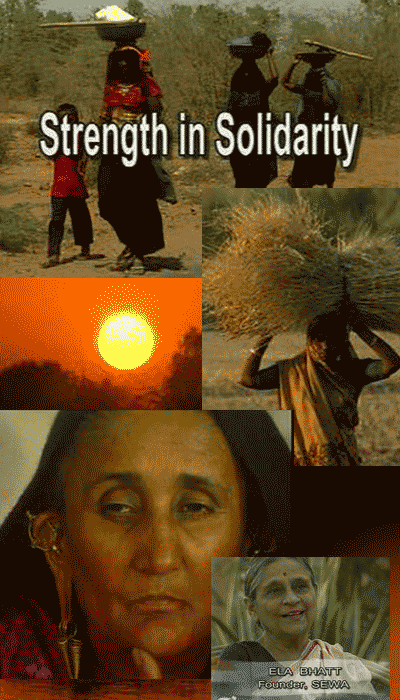The Solidarity Economy in India
home . SEWA . Action India . Navdanya . Get Involved!
The SEWA movement: Bringing Soladaristic Social Change to India
The Self-Employed Women’s Association (SEWA) is a trade union located in Ahmedabad, India. It is an organization that seeks to protect women who are self-employed in small businesses or occupations with intensive labor through microfinance programs, cooperative systems, and legal services. SEWA seeks to organize the informal female worker sector of India and help to make what was once an invisible female workforce, visible.
From the start, SEWA sought alternatives for confronting issues for women as opposed to simply demanding for change. “Besides agitating against conditions, SEWA women have a positive vision of the society they are working toward. They perceive that alternative structures could positively create this reality.” (Rose 23) One of SEWA’s main ‘alternative’ approaches towards bettering the lives of women is a ever-increasing all-women cooperative system in rural and urban areas. These have included banking cooperatives, service, production and worker cooperatives. “Through its concrete experiences in developing these, SEWA has seen that cooperatives can provide a structure for women to control their own assets and to come together on the basis of their work, where they are both the owners and workers...SEWA builds women’s cooperatives as modern extensions of the traditional system of self-employment,” where people work collectively and have ownership over their own means of production. The small size of the cooperatives allows for women to go at their own pace and grow as individuals. It also allows for small business to address local needs and work to break down the caste system that so often marginalizes women in India.
While SEWA’s main focus is achieving full and fair employment for women in India, the nature of their work often leads to a necessary combining of issues that Indian women and men are facing today. For example, SEWA has pursued a Green Women’s Development initiative through their cooperative programs: “With most commons facing increasing degradation, SEWA wanted to develop models for women to regenerate both subsistence and income resources on wastelands as a way to reverse environmental degradation and women’s poverty.” (Rose 221) These efforts make an strong case for women’s integral relationships with the ecological and social movements worldwide.
SEWA’s goal is to “generate self-respect needed to resist exploitation, to demand change collectively and refrain from violence under such oppressive economic and social situations.” (Rose 34) They are working to achieve this by raising women’s consciousnesses from all castes of society. There ideology is “that women from all levels of society join together to plan with rather than planning for poor women.” (Rose 29). SEWA women respect the process it takes to achieve social change just as much as the end results. They understand that it takes more than a miracle to make a difference—just as Gandhi believed during the early social movement in India. Groups must organize and unify in order create social change. SEWA’s contributions to social transformation have helped to break India away from traditionalism, communism and fundamentalism. “The SEWA movement is enhanced by its being a sangam or confluence of three movements : the labour movement, the cooperative movement and the women’s movement.” (www.sewa.org) SEWA has helped to “develop the solidarity necessary to overcome the powerful pull of the old power structures, old feuds, and social pressure against women’s control.” (Rose 226) SEWA has become a leader for creating a more soladaristic future in India and has created a more soladaristic approach to women and international development.
WORKS CITED:
Rose, Kalima. Where Women Are Leaders: The SEWA Movement in India. Zed Books Ltd: London. 1992.
Self Employed Women’s Association. < http://www.sewa.org/>. (2 May 2010)

